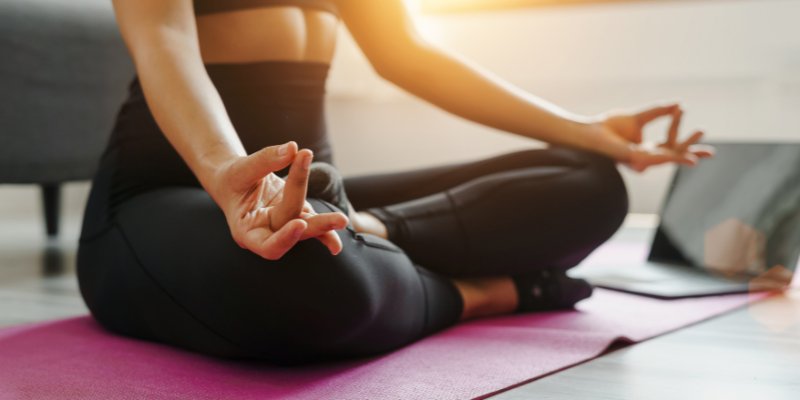Beginners may benefit from yoga's comprehensive approach, making it an excellent place to start fitness or a healthier lifestyle. This article introduces beginner-friendly yoga positions. Novice yoga practitioners may gain confidence by learning the essential positions and their effects on the mind, body, and spirit. Yoga is essential for beginners because of its adaptability and accessibility. Beginner yoga improves flexibility, strength, and mental relaxation, improving well-being.
This article guides beginners through the foundational yoga positions. Understanding these fundamental postures prepares yoga for future breakthroughs. This introduction prepares students to start yoga confidently and passionately by describing key positions and their benefits. It encourages newcomers to discover yoga's broad universe and improve their lives for a more balanced, peaceful living.

Understanding Yoga for Beginners:
New yoga practitioners get several advantages. It helps novices gain flexibility, strength, and posture. It also improves mental clarity and relaxation, reducing stress and developing mindfulness. Beginners may see the comprehensive benefits of yoga with this awareness.
Correct posture and breathing are essential to initial practice. Beginning postures are safe and effective when novices master these basics. Yoga posture aligns the body for optimal benefit from each practice. Practicing aware and attentive breathing relaxes and promotes movement, producing a harmonious body-breath connection.
Body awareness is essential for yoga beginners. Beginners may practice safely and sustainably by listening to their bodies, respecting their limits, and progressively progressing through postures. This understanding fosters mindfulness and patience for beginners to create a strong yoga practice.
Foundation Poses for Beginners:
Tadasana: Mountain Pose is the basis of standing yoga poses. Beginners learn the importance of proper posture via its alignment basics. Standing tall and anchoring through the feet aligns the body, strengthens the legs, and engages the core. This position is a good beginning point for body alignment awareness and more advanced postures.
Downward-Facing Dog (Adho Mukha Svanasana): This classic yoga practice stretches the whole body. Beginners feel lengthening in the back, hamstrings, and calves. It balances spine lengthening and strengthening via stretching and decompressing. This position teaches novices to full-body stretching and flexibility by engaging many muscle groups.
Child's Pose (Balasana): Beginners may relax in Child's Pose. This position targets the back, hips, thighs, and ankles. It's a great yoga resting pose for surrender and release. The position emphasizes yoga's significance of relaxation and repair by encouraging comfort. Beginning practitioners learn the importance of rest and regeneration from this essential resting position.
Standing Poses for Beginners:
Beginner yoga standing postures are fundamental. Warrior I, II, and Tree Pose teach beginners strength, balance, and attention. Virabhadrasana I—Warrior I—focuses on strength, stability, and alignment. This essential standing position strengthens the legs and stretches the chest and shoulders. It promotes balance and attention by aligning the hips and provides a robust platform for novices learning standing yoga poses.
Strength and flexibility are built in Warrior II or Virabhadrasana II. This position builds leg strength, hip opening, and chest expansion. It helps practitioners coordinate breath and movement for stamina, alignment, and mind-body connection. Yoga novices learn endurance and focus with Warrior II.
Vrksasana—Tree Pose—adds balance and stability. This stance strengthens legs and improves posture, helping practitioners concentrate. It stresses the significance of a steady gaze stabilizing the body and integrating mind and body. Tree Pose promotes balance, stability, and attention in yoga.
These standing postures introduce novices to yoga basics, including alignment, stability, and mental attention. They inspire yoga beginners with a balanced, strength-building, and meditative practice.
Relaxation and Restorative Poses:
Beginners need yoga, relaxation, and restorative practices. These postures promote relaxation, stress reduction, and healing. Savasana (Corpse Pose) helps practitioners relax and concentrate on breathing. Another relaxing pose is the Supported Child's Pose, which stretches the spine and hips.
These positions relax the mind and neurological system. They relieve tension, helping novices relax after more vigorous yoga poses; including these postures in a practice session balances exertion and repair, healing the body and mind.

Safety Tips for Beginners:
Safety is crucial in yoga, particularly for beginners. This section highlights many safety recommendations for yoga novices. Preventing injuries requires proper alignment to place the body appropriately in each posture and reduce strain. Beginners must progressively ease into postures, respecting their body's boundaries and increasing strength and flexibility.
In yoga, listening to the body is essential. Avoid overexertion by mindfully observing how each position affects the body. A thoughtful, compassionate technique that allows the body to respond prevents injury and promotes a sustained yoga practice. Staying present in the practice with breath awareness makes it more thoughtful and regulated. This section helps novices practice yoga safely and sustainably. It fosters mindfulness, progressive growth, and body listening, fostering a safe, injury-free practice that allows people to improve while protecting their health.
Breathing Techniques for Beginners:
Learning breathing methods is essential for beginners in yoga. Foundational methods include Ujjayi breath or Victorious Breath. The back of the throat is gently constricted, making an oceanic sound when inhaled and exhaled. Beginners find a rhythm, concentration, and a steady breath with ujjayi breath, nurturing calm.
Another critical method is Dirga Pranayama or Three-Part Breath. Deep breathing into the belly, ribs, and upper chest is required. This method helps novices take deep breaths to expand their lungs and relax. It calms the mind, reduces tension, and boosts oxygenation, renewing the body.
Basic breath awareness methods teach beginners to concentrate on the breath. It involves observing the natural breath, inhaling, and exhaling without change. This technique promotes mindfulness, presence, and body-breath connection, helping practitioners relax and center themselves. Understanding yoga breath is crucial. These breathing methods help novices synchronize movement with breath, relax the mind, and improve their yoga experience, laying the groundwork for their practice.
Conclusion:
The conclusion summarises the article's main points. Beginners are encouraged to practice yoga patiently and consistently. Yoga progresses slowly, so starting gently and being patient is encouraged. As the conclusion states, regular practise is essential to experience yoga's transforming advantages.
The conclusion emphasizes yoga's physical and emotional advantages for novices. It emphasizes that yoga is about self-discovery, patience, and inner progress, not just positions. Beginners in yoga should have an open mind and be nice to themselves. This part finishes by encouraging novices to dedicate themselves to yoga, which promotes a healthy, peaceful, and attentive existence.




